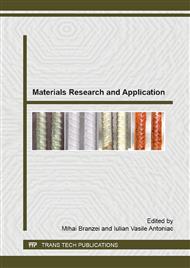p.160
p.166
p.172
p.183
p.190
p.196
p.206
p.214
p.219
Multilayer Ceramic Materials Testing under the Terms of High Heating-Cooling Gradients
Abstract:
Increasing the functional parameters and endurance of the turbines, blades systems, rocket engines, high-performance metallurgical installations, power energy require the creation of new systems for integrated assessment, testing-investigating.From the ensemble of wear factors acting simultaneously on the multilayer ceramic materials, associated to the coatings structures, the quick thermal shock acts most disruptive.To illustrate the effect of gradients with high value for heating-cooling the authors have designed and developed a versatile installation with semi-automatic functioning and monitoring test parameters. The fundamental testing parameter that the installation uses is heating-cooling speed up to 100 ° C/s, which is superior to the performances of the known testing installations.The extreme thermal shock testing parameters generate in the multilayers ceramic structures, triplex type with intermediate layer, structural, morphological and composition modifications which initiate and develop the ceramic layer spallation.
Info:
Periodical:
Pages:
190-195
Citation:
Online since:
July 2015
Authors:
Keywords:
Price:
Сopyright:
© 2015 Trans Tech Publications Ltd. All Rights Reserved
Share:
Citation:


